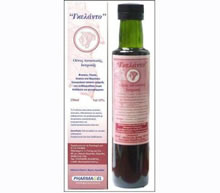
Λεξικό .. Extrinsic bronchial Asthma
Extrinsic bronchial Asthma
The European Academy of Allergology and Clinical Immunology has proposed a revised terminology for allergic and allergy-related reactions that can be used independently of target organ of patient age group. The proposed terminology is based on the present knowledge of the mechanisms which initiate and mediate allergic reactions. 'Hypersensitivity' is an umbrella term, 'allergy' involves a hypersensitivity reaction which is initiated by an immunological mechanism, and 'atopy' is an individual or familial tendency to produce IgE antibodies in response to low doses of allergens, and is accompanied by the typical symptoms or asthma, rhino-conjunctivitis or eczema/dermatitis.
Each condition should be categorised als 'allergic/not allergic', and the allergic conditions should be further categorised as 'IgE-mediated/non IgE-mediated' (sometimes: 'IgE-associated'). Terms which are no longer in use include: 'idiosyncrasy' (this will now become 'hypersensitivity'); 'pseudo-allergy' ('non-allergic hypersensitivity'); 'extrinsic', 'intrinsic', 'endogenous' and 'exogenous asthma' ('allergic' (possibly 'IgE-mediated') and 'non-allergic asthma'); 'atopic eczema' ('atopic eczema/dermatitis syndrome'; 'allergic (possibly 'EgE-mediated') or 'non-allergic'); 'intrinsic' and 'cryptogenic variants of eczema' (non-allergic atopic eczema/dermatitis syndrom'); 'food intolerance' (non-allergic food hypersensitivity') and 'anaphylactoid reaction' ('non-allergic anaphylaxis') [1].The term extrinsic asthma is not in use today, but it was used for the allergic asthma (possibly IgE mediated), which affects children and young adults (see asthma). It is characterized by paroxysms of bronchospasm with wheezing, dyspnea and other symptoms of respiratory distress following exposure to causative allergens. It is associated with positive immediate skin prick tests and a personal or family history of asthma, high fever and eczema. It is an IgE mediated condition. Congenital and environmental factors act together in the expression of the disease.
Pathophysiology: Epithelial defects or open junctions between epithelial cells enable the allergen to penetrate the submucosa. And to sensitize the T-lymphocytes which in turn stimulate B-lymphocytes. This is regulated by T-helper and T-suppressor cells. B-lymphocytes subdivide and change into plasma cells which produce IgE antibodies. IgE reach the tissue mast cells in the skin and the airway mucosa via the blood stream. Mast cells can also be found in the lumen of the bronchi. With subsequent exposure of the sensitized mast cell to the allergen, a bridging between neighboring IgE molecules is affected. This results in the release of mediators stored in the granules. These mediators are responsible for: bronchoconstriction, hypersecretion from mucous glands and mucosal edema. In addition, so called secondary mediators are formed from components of the cell membrane. In the first step, the conversion of membrane phospholipids into arachidonic acid, the enzyme phospholipase A play a key role.
The glucocorticosteroids act an antiinflammatory effect inhibiting phospholipase A by a specific protein, macrocortin. Via two different metabolic pathways catalyzed by the enzymes lipoxygenase and cyclooxygenase, leukotrienes and hydroxy fatty acids are formed on the one hand, and thromboxane, prostacyclin and prostaglandin on the other. These mediators have multiple actions and additionally regulate bronchomotor tone and the activity of the mucous glands. The allergic reaction, it is assumed, is initiated in the mast cells located in the airway lumen. The released mediators open the tight junctions, so that macromolecules can penetrate into the submucosa to stimulate the larger number of mast cells there. So the reaction may be amplified. The immediate allergic reaction may be followed by a delayed but protracted inflammatory response known as the late allergic reaction. In this response are participating the leukotrienes and chemotactic factors that attract eosinophil and neutrophil granulocytes. (See Asthma, molecular mechanisms involved in asthmatic airway inflammation).
References
Gerth van Wijk R, van Cauwenberge PB, Johansson SG. Revised terminology for allergies and related conditions.Ned Tijdschr Tandheelkd. 2003 Aug;110(8):328-31.
Γκέλης Ν.Δ. - Λεξικό Αλλεργίας - Εκδόσεις ΒΕΛΛΕΡOΦΟΝΤΗΣ - Κόρινθος 2013
Gelis Ν.D. - Dictionary of Allergies - VELLEROFONTIS Publications - Corinth 2013




